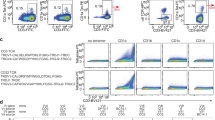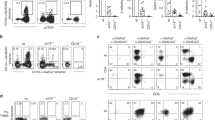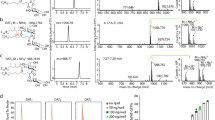Abstract
A central paradigm in αβ T cell–mediated immunity is the simultaneous co-recognition of antigens and antigen-presenting molecules by the αβ T cell antigen receptor (TCR). CD1a presents a broad repertoire of lipid-based antigens. We found that a prototypical autoreactive TCR bound CD1a when it was presenting a series of permissive endogenous ligands, while other lipid ligands were nonpermissive to TCR binding. The structures of two TCR-CD1a-lipid complexes showed that the TCR docked over the A′ roof of CD1a in a manner that precluded direct contact with permissive ligands. Nonpermissive ligands indirectly inhibited TCR binding by disrupting the TCR-CD1a contact zone. The exclusive recognition of CD1a by the TCR represents a previously unknown mechanism whereby αβ T cells indirectly sense self antigens that are bound to an antigen-presenting molecule.
This is a preview of subscription content, access via your institution
Access options
Subscribe to this journal
Receive 12 print issues and online access
$209.00 per year
only $17.42 per issue
Buy this article
- Purchase on Springer Link
- Instant access to full article PDF
Prices may be subject to local taxes which are calculated during checkout







Similar content being viewed by others
References
Eckle, S.B.G., Turner, S.J., Rossjohn, J. & McCluskey, J. Predisposed αβ T cell antigen receptor recognition of MHC and MHC-I like molecules? Curr. Opin. Immunol. 25, 653–659 (2013).
Bhati, M., Cole, D.K., McCluskey, J., Sewell, A.K. & Rossjohn, J. The versatility of the αβ T-cell antigen receptor. Protein Sci. 23, 260–272 (2014).
Rossjohn, J. et al. T cell antigen receptor recognition of antigen-presenting molecules. Annu. Rev. Immunol. 10.1146/annurev-immunol-032414-112334 (10 December 2014).
Zinkernagel, R.M. & Doherty, P.C. Restriction of in vitro T cell-mediated cytotoxicity in lymphocytic choriomeningitis within a syngeneic or semiallogeneic system. Nature 248, 701–702 (1974).
Brigl, M. & Brenner, M.B. CD1: antigen presentation and T cell function. Annu. Rev. Immunol. 22, 817–890 (2004).
Ly, D. & Moody, D.B. The CD1 size problem: lipid antigens, ligands, and scaffolds. Cell. Mol. Life Sci. 71, 3069–3079 (2014).
Zajonc, D.M., Elsliger, M.A., Teyton, L. & Wilson, I.A. Crystal structure of CD1a in complex with a sulfatide self antigen at a resolution of 2.15 Å. Nat. Immunol. 4, 808–815 (2003).
Scharf, L. et al. The 2.5Å structure of CD1c in complex with a mycobacterial lipid reveals an open groove ideally suited for diverse antigen presentation. Immunity 33, 853–862 (2010).
Gadola, S.D. et al. Structure of human CD1b with bound ligands at 2.3 Å, a maze for alkyl chains. Nat. Immunol. 3, 721–726 (2002).
de Jong, A. et al. CD1a-autoreactive T cells recognize natural skin oils that function as headless antigens. Nat. Immunol. 15, 177–185 (2014).
Rossjohn, J., Pellicci, D.G., Patel, O., Gapin, L. & Godfrey, D.I. Recognition of CD1d-restricted antigens by natural killer T cells. Nat. Rev. Immunol. 12, 845–857 (2012).
Porcelli, S. et al. Recognition of cluster of differentiation 1 antigens by human CD4-CD8- cytolytic T lymphocyte. Nature 341, 447–450 (1989).
de Jong, A. et al. CD1a-autoreactive T cells are a normal component of the human αβ T cell repertoire. Nat. Immunol. 11, 1102–1109 (2010).
de Lalla, C. et al. High-frequency and adaptive-like dynamics of human CD1 self-reactive T cells. Eur. J. Immunol. 41, 602–610 (2011).
Altman, J.D. et al. Phenotypic analysis of antigen-specific T lymphocytes. Science 274, 94–96 (1996).
Reantragoon, R. et al. Antigen-loaded MR1 tetramers define T cell receptor heterogeneity in mucosal-associated invariant T cells. J. Exp. Med. 210, 2305–2320 (2013).
Kasmar, A.G. et al. CD1b tetramers bind αβ T cell receptors to identify a mycobacterial glycolipid-reactive T cell repertoire in humans. J. Exp. Med. 208, 1741–1747 (2011).
Kasmar, A.G. et al. Cutting edge: CD1a tetramers and dextramers identify human lipopeptide–specific T cells ex vivo. J. Immunol. 191, 4499–4503 (2013).
Reantragoon, R. et al. Structural insight into MR1-mediated recognition of the mucosal associated invariant T cell receptor. J. Exp. Med. 209, 761–774 (2012).
Huang, S. et al. Discovery of deoxyceramides and diacylglycerols as CD1b scaffold lipids among diverse groove-blocking lipids of the human CD1 system. Proc. Natl. Acad. Sci. USA 108, 19335–19340 (2011).
Layre, E. et al. A comparative lipidomics platform for chemotaxonomic analysis of Mycobacterium tuberculosis. Chem. Biol. 18, 1537–1549 (2011).
Bourgeois, E.A. et al. Bee venom processes human skin lipids for presentation by CD1a. J. Exp. Med. 10.1084/jem.20141505 (12 January 2015).
López-Sagaseta, J., Sibener, L.V., Kung, J.E., Gumperz, J. & Adams, E.J. Lysophospholipid presentation by CD1d and recognition by a human natural killer T-cell receptor. EMBO J. 31, 2047–2059 (2012).
Zeissig, S. et al. Hepatitis B virus-induced lipid alterations contribute to natural killer T cell-dependent protective immunity. Nat. Med. 18, 1060–1068 (2012).
Zajonc, D.M. et al. Molecular mechanism of lipopeptide presentation by CD1a. Immunity 22, 209–219 (2005).
Adams, E.J. & Luoma, A.M. The adaptable major histocompatibility complex (MHC) fold: structure and function of nonclassical and MHC class I–Like molecules. Annu. Rev. Immunol. 31, 529–561 (2013).
Koch, M. et al. The crystal structure of human CD1d with and without α-galactosylceramide. Nat. Immunol. 6, 819–826 (2005).
Adams, E.J., Chien, Y.H. & Garcia, K.C. Structure of a γδ T cell receptor in complex with the nonclassical MHC T22. Science 308, 227–231 (2005).
Tikhonova, A.N. et al. αβ T cell receptors that do not undergo major histocompatibility complex-specific thymic selection possess antibody-like recognition specificities. Immunity 36, 79–91 (2012).
Gapin, L., Godfrey, D.I. & Rossjohn, J. Natural killer T cell obsession with self-antigens. Curr. Opin. Immunol. 25, 168–173 (2013).
Vincent, M.S. et al. CD1-dependent dendritic cell instruction. Nat. Immunol. 3, 1163–1168 (2002).
Colonna, M. Skin function for human CD1a-reactive T cells. Nat. Immunol. 11, 1079–1080 (2010).
Kjer-Nielsen, L. et al. A structural basis for selection and cross-species reactivity of the semi-invariant NKT cell receptor in CD1d/glycolipid recognition. J. Exp. Med. 203, 661–673 (2006).
Aricescu, A.R., Lu, W. & Jones, E.Y. A time- and cost-efficient system for high-level protein production in mammalian cells. Acta Crystallogr. D Biol. Crystallogr. 62, 1243–1250 (2006).
Gras, S. et al. The shaping of T cell receptor recognition by self-tolerance. Immunity 30, 193–203 (2009).
Mallevaey, T. et al. A molecular basis for NKT cell recognition of CD1d-self-antigen. Immunity 34, 315–326 (2011).
Uldrich, A.P. et al. CD1d-lipid antigen recognition by the γδ TCR. Nat. Immunol. 14, 1137–1145 (2013).
Kabsch, W. XDS. Acta Crystallogr. D Biol. Crystallogr. 66, 125–132 (2010).
Battye, T.G., Kontogiannis, L., Johnson, O., Powell, H.R. & Leslie, A.G. iMOSFLM: a new graphical interface for diffraction-image processing with MOSFLM. Acta Crystallogr. D Biol. Crystallogr. 67, 271–281 (2011).
McCoy, A.J. Solving structures of protein complexes by molecular replacement with Phaser. Acta Crystallogr. D Biol. Crystallogr. 63, 32–41 (2007).
Eckle, S.B. et al. A molecular basis underpinning the T cell receptor heterogeneity of mucosal-associated invariant T cells. J. Exp. Med. 211, 1585–1600 (2014).
Adams, P.D. et al. PHENIX: a comprehensive Python-based system for macromolecular structure solution. Acta Crystallogr. D Biol. Crystallogr. 66, 213–221 (2010).
DiMaio, F. et al. Improved low-resolution crystallographic refinement with Phenix and Rosetta. Nat. Methods 10, 1102–1104 (2013).
Emsley, P. & Cowtan, K. Coot: model-building tools for molecular graphics. Acta Crystallogr D Biol Crystallogr 60, 2126–2132 (2004).
Winn, M.D. et al. Overview of the CCP4 suite and current developments. Acta Crystallogr. D Biol. Crystallogr. 67, 235–242 (2011).
Baker, N.A., Sept, D., Joseph, S., Holst, M.J. & McCammon, J.A. Electrostatics of nanosystems: application to microtubules and the ribosome. Proc. Natl. Acad. Sci. USA 98, 10037–10041 (2001).
Acknowledgements
We thank L. Tan, M. Bhati, J. Waddington, B. O'Sullivan, M. Ciula and staff at the Australian synchrotron and the Monash macromolecular crystallization facility for technical assistance; P. Savage (Brigham Young University) for α-galactosylceramide; S.A. Porcelli (Albert Einstein College of Medicine) for the BK6 clone; and J. Altman for the design of CD1a protein expression constructs. Supported by NIAID (R01 AR048632 and AI049313 to D.B.M.), the National Health and Medical Research Council of Australia (1013667; Early Career Fellowship to D.G.P.; Senior Principal Research Fellowship 1020770 to D.I.G.; and NHMRC Australia Fellowship AF50 to J.R.), the Australian Research Council (CE140100011 and LE110100106; Future Fellowships to S.G. and A.P.U.) and the Dermatology Foundation (A.d.J.).
Author information
Authors and Affiliations
Contributions
R.W.B. and D.G.P. performed experiments, provided intellectual input and analyzed data; T.-Y.C., A.N.K., M.S.-R., S.G., A.d.J. & A.P.U. performed experiments, analyzed data, and/or provided intellectual input; and D.B.M., D.I.G. and J.R. led the investigation, devised the project and wrote the manuscript together.
Corresponding authors
Ethics declarations
Competing interests
The authors declare no competing financial interests.
Integrated supplementary information
Supplementary Figure 1 BK6 TCR variable sequence and SDS-PAGE from size-exclusion chromatography formation of complexes of the BK6 TCR and CD1a-lipid.
(a) Protein sequence for the BK6 TCR highlighting the CDR from germline encoded regions and recombination. (b) A non-reducing SDS-PAGE gel indicating bands associated with the BK6 TCR alone, CD1a-endo alone and fractions from the SEC chromatogram displayed in Fig. 1b. Elution volumes are indicated for the start of the fraction, collection the subsequent 1 ml elution volume and STD indicates a protein molecular weight standard ladder.
Supplementary Figure 2 Mass spectrometry analysis of CD1a monomers and CD1a loaded with PE-rhodamine.
(a) Normal phase (HPLC-QToF-MS) from CD1a monomers that did not complex with the BK6 TCR using size exclusion chromatography. (b, c) CD1a proteins loaded with endogenous lipids (CD1a-endo) were or were not treated with rhodamine labeled phosphatidylethanolamine(PE-rhodamine) followed by elution with organic solvents as in Fig. 1 as well as negative mode nanospray electrospray ionization mass spectrometry (b) or HPLC-QTof-MS (c). Lipids were identified as phosphatidylinositol (PI), phosphatidylcholine (PC) or sphingomyelin (SM) based on CID-MS and comparison to authentic standards as shown in Fig. 1.
Supplementary Figure 3 Electron density maps for the lipids in the CD1a ternary and CD1a binary structures.
(a-d) Representation of the CD1a lipid binding cleft showing σ-weighted (a-d) 2Fo-Fc refined density peaks above an r.m.s.d. of 0.8 in blue and (e-h) Fo-Fc simulated annealing omit maps contoured at an r.m.s.d. of 2.5 in green around the (a, e) oleic acid (OLA), (b, f) LPC from the BK6 TCR-CD1a ternary complexes or (c, g) sphingomyelin (SM), (d, h)LPC) CD1a binary complexes. CD1a is shown in white in ribbon representation and lipids in stick format colored according to atom type with cyan carbons for LPC, salmon pink carbons for oleic acid and white carbons for sphingomyelin.
Supplementary Figure 4 Fatty acids eluted from BK6 TCR–CD1a–endo complexes.
Fatty acyl chain composition revealed by HPLC-QToF-MS from (a) purified BK6 TCR-CD1a-endo ternary crystals, (b) BK6 TCR-CD1a-endo complexes from size exclusion chromatography.
Supplementary Figure 5 CD1a-sulfatide tetramer staining of Jurkat.BK6 cells.
BK6.Jurkat cells or control MR1 restricted Jurkat cells were labeled with CD1a-endo tetramer or tetramer loaded with sulfatide at a 1:6 protein:lipid molar ratio. Cells were gated for similar levels of GFP expression and Mean Fluorescence Intensity (MFI) of CD1a tetramer is shown in the upper right corner. FACS plots are representative of 3 independent experiments.
Supplementary Figure 6 Collision-induced dissociation (CID-MS) analysis of lipids eluted from BK6 TCR–CD1a–endo complexes.
Negative mode nanospray ESI-MS (a) of lipid eluting from CD1a-TCR complexes using methods shown in Fig. 1. After lipids were tentatively identified as PG (b), PI (c), PC (d) and SM (e) based on mass, CID-MS of each molecule confirmed the expected fragments corresponding to those presented in Fig. 2c.
Supplementary information
Supplementary Text and Figures
Supplementary Figures 1–6 and Supplementary Tables 1 and 2 (PDF 4699 kb)
Rights and permissions
About this article
Cite this article
Birkinshaw, R., Pellicci, D., Cheng, TY. et al. αβ T cell antigen receptor recognition of CD1a presenting self lipid ligands. Nat Immunol 16, 258–266 (2015). https://doi.org/10.1038/ni.3098
Received:
Accepted:
Published:
Issue Date:
DOI: https://doi.org/10.1038/ni.3098
This article is cited by
-
CD1-mediated immune responses in mucosal tissues: molecular mechanisms underlying lipid antigen presentation system
Experimental & Molecular Medicine (2023)
-
Staphylococcal phosphatidylglycerol antigens activate human T cells via CD1a
Nature Immunology (2023)
-
CD1a promotes systemic manifestations of skin inflammation
Nature Communications (2022)
-
Dynamic plasticity of the lipid antigen-binding site of CD1d is crucially favoured by acidic pH and helper proteins
Scientific Reports (2020)
-
A T-cell receptor escape channel allows broad T-cell response to CD1b and membrane phospholipids
Nature Communications (2019)



